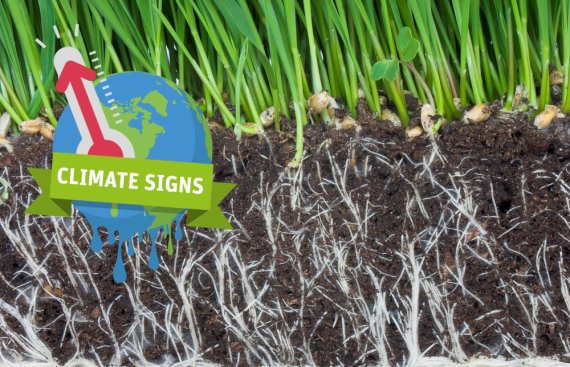| "Climate signs" | Climate change is not about the future — it is happening now and we can already see the effects. In its ‘Climate Signs’ series, Resource will be looking over the summer at how climate change affects people’s daily lives all around the world and what WUR researchers are doing about this issue. |
|---|
Why is it important not to ignore soil organisms in the climate debate?
‘Certain soil organisms pass on minerals from the soil to plant roots in exchange for sugars. As such, they play an important role in nutrition but also in the water absorption and resilience of the plant. Despite their bad name, pathogenic soil organisms have an equally important function in nature. They prevent certain plant species from dominating and thus stimulate species diversity. Climate change influences the microscopic life in the soil. Some soil organisms are able to withstand higher temperatures or drought better than others. Climate change kills certain soil organisms or forces them to move to other habitats (area shift). That leads to a change in the composition of soil life.’

After an area shift, plants and soil organisms must create new forms of cohabitation.
Professor Wim van der Putten, soil ecologist in the Nematology chair group and affiliated with the department of Terrestrial Ecology at NIOO-KNAW.
What effect does this have on plants?
‘The soil organisms influence the chemical composition of plants through the supply of nutrients such as nitrogen and phosphate. These are also important building blocks for biologically active cells such as signalling receptors and antibodies. In this way, soil life has an effect on the resistance of plants. In addition, an area shift disrupts the interactions between plants and the soil organisms. After such a shift, plants and soil organisms must create new forms of cohabitation. This can lead to problems, for example when no specific interactions arise between a plant and pathogens in a new soil composition. That plant could then become invasive and outcompete other (native) plant species.’
What does the changed soil composition mean for agriculture?
‘Dutch agriculture uses a lot of artificial fertilisers, liquid manure and tillage such as ploughing. This is especially harmful for fungi in the soil and leads to a bacterium-dominated agricultural land. Bacteria are more sensitive to extreme weather conditions than fungi, making Dutch agricultural land more susceptible to climate change than natural soils that have a greater diversity of soil organisms.’
To make agricultural soils resilient to climate change, we should promote the fungal components in agricultural land.
What next?
‘Fungi are more resistant to climate change; they increase the soil’s robustness and decrease its sensitivity to extreme drought. To make agricultural soils resilient to climate change, we should promote the fungal components in agricultural land. But that also means that we have to grow crops that are better fit to handle fungi. We are currently investigating which plant characteristics are suitable for this. Together with the Molecular Biology Group, we are studying a model plant, rockcress (Arabidopsis), during a change from a bacterium‑dominated to a fungus‑dominated soil. From the blueprint of this model plant, we hope to learn how we can optimise agricultural crops.’
Additional reading:
Drought: will quinoa replace potatoes?
Increased heat stress in Dutch cities
From giant ticks to super-ants: invasive species are on their way

